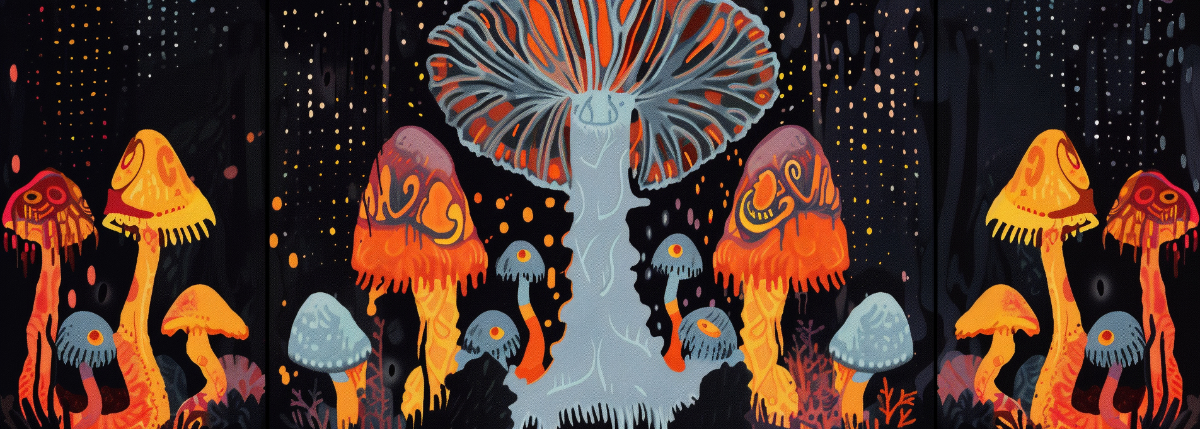Preparing for your first psychedelic session can be both exciting and nerve-wracking. To get the full benefits from the therapeutic, coaching, or personal use of psychedelics, it’s essential to understand the history, benefits, risks, and considerations involved.
This guide will help you navigate the mental, emotional, and physical preparation required for a successful experience.
Key Takeaways
- Understand the history and background of psychedelic therapy to have a better context for your session.
- Set clear intentions before the session to guide your experience and focus your mind.
- Conduct a mental health assessment with a qualified professional to ensure you are prepared for the therapy.
- Practice integration techniques post-session to incorporate the insights gained into your daily life.
- Follow dietary guidelines, prioritize sleep and rest, and create a comfortable physical environment to enhance the therapeutic effects of psychedelics.
Understanding Psychedelic Therapy

History of Psychedelic Therapy
Psychedelic therapy has a rich and complex history, tracing back to ancient times when indigenous cultures used natural psychedelics for spiritual and healing purposes. Modern psychedelic therapy emerged in the mid-20th century, with researchers exploring the therapeutic potential of substances like LSD and psilocybin.
The resurgence of interest in the 21st century has led to a renaissance in psychedelic research, with studies focusing on treatment-resistant conditions.
- 1950s: Discovery of LSD’s psychoactive effects
- 1960s: Initial wave of research and therapeutic use
- 1970s: Legal restrictions halt clinical studies
- 2000s: Revival of research into therapeutic applications
This timeline highlights the ebb and flow of psychedelic therapy’s acceptance and the shifting perspectives on its place in mental health treatment.
Expanded History of Psychedelic Therapy
Ancient Use to Early 20th Century
- Indigenous Practices: For thousands of years, indigenous cultures around the world have used natural psychedelics, such as psilocybin mushrooms, ayahuasca, and peyote, in sacred rituals for spiritual awakening and healing.
- Early Recognition: In the late 19th to early 20th century, Western scientists and explorers began documenting the use of psychedelics in indigenous ceremonies, sparking curiosity in their potential for research and therapeutic use.
1950s: Discovery and Early Experiments
- Discovery of LSD: In 1943, Swiss chemist Albert Hofmann accidentally discovered the psychoactive effects of LSD, leading to its exploration as a therapeutic tool in psychotherapy, known as “psycholytic therapy.”
- Psilocybin in the West: In the late 1950s, R. Gordon Wasson, a mycologist, and his wife Valentina P. Wasson, a physician, participated in indigenous mushroom ceremonies in Mexico, bringing psilocybin to the attention of Western medicine.
1960s: Golden Era of Psychedelic Research
- Pioneering Studies: Researchers like Timothy Leary and Richard Alpert (later known as Ram Dass) at Harvard University began experimenting with LSD and psilocybin, suggesting their potential for treating various psychological conditions and for spiritual growth.
- Widespread Interest: The 1960s saw a surge in psychedelic research, with studies indicating positive outcomes in treating alcoholism, depression, and anxiety in terminal cancer patients.
1970s: Backlash and Prohibition
- Growing Controversy: As LSD and other psychedelics became associated with the counter-culture movement, public and governmental concerns grew over their non-medical use and potential for abuse.
- Legal Restrictions: By the early 1970s, the United States and many other countries had classified psychedelics as Schedule I substances, effectively halting clinical research and therapeutic use.
2000s: Psychedelic Renaissance
- Revival of Research: Beginning in the late 1990s and accelerating in the 2000s, regulatory bodies started granting approvals for controlled studies on psychedelics, marking the beginning of a new era of research.
- Significant Findings: Studies at institutions like Johns Hopkins University and Imperial College London have shown promising results of psychedelics in treating depression, PTSD, addiction, and existential anxiety related to terminal illness.
- Psychedelic-Assisted Psychotherapy: The contemporary model of psychedelic therapy often combines the use of substances like psilocybin or MDMA with psychotherapy sessions, focusing on preparation, the psychedelic experience, and integration phases.
Current and Future Perspectives
- FDA Designations: The U.S. Food and Drug Administration (FDA) has designated psilocybin therapy as a “breakthrough therapy” for treatment-resistant depression, accelerating the development and review process.
- Global Interest: Psychedelic research is now a global endeavour, with studies underway across continents. Countries like Canada and parts of the United States have begun to change their laws regarding psychedelic substances, reflecting a more open stance towards their potential therapeutic benefits.
☝️ click on the toggles to learn more about a specific topic ☝️
Benefits of Psychedelic Therapy
Psychedelic therapy has been associated with a range of potential benefits that extend beyond traditional treatment methods. Enhanced self-awareness and emotional release are often reported by participants, which can lead to significant therapeutic breakthroughs.
- Improved mental health: Many individuals experience reductions in symptoms of depression, anxiety, and PTSD after psychedelic therapy sessions.
- Cognitive flexibility: There is evidence suggesting that psychedelics can help break rigid thought patterns, allowing for new perspectives.
- Increased openness: Patients often feel more open to new experiences and perspectives following therapy.
It’s important to note that while the benefits can be profound, they are best achieved within a structured and supportive environment.
At the heart of psychedelic therapy’s effectiveness is its profound impact on the brain’s functioning. Research suggests that substances like psilocybin and LSD can temporarily disrupt the default mode network (DMN), a brain network associated with self-referential thoughts and the ego.
This disruption can lead to a state of heightened plasticity, where the brain forms new connections and pathways. By facilitating this neuroplasticity, psychedelics can help individuals break free from entrenched patterns of thought and behaviour, offering new perspectives and solutions to old problems. This mechanism is thought to underlie the improvements in mental health conditions, as it allows individuals to confront and process emotional experiences in new and healing ways.
Studies tracking the long-term effects of psychedelic therapy have shown promising results. For instance, research from Johns Hopkins University found that a single high-dose psilocybin session provided lasting relief from depression and anxiety symptoms for up to six months in cancer patients.
Other studies have documented sustained increases in openness and other positive changes in personality traits, suggesting that the benefits of psychedelic therapy can extend well beyond the immediate aftermath of the experience. These long-term impacts underscore the potential of psychedelics to effect enduring change, challenging the transient nature of benefits seen with some traditional therapies.
When compared to conventional mental health treatments, psychedelic therapy offers a unique and often more rapid pathway to improvement for certain conditions. Clinical trials have indicated that psychedelics can achieve significant reductions in symptoms of depression, anxiety, and PTSD, sometimes after just one or two sessions.
This contrasts with traditional therapies, like SSRIs or talk therapy, which may take weeks or months to show effects and often come with a range of side effects. While not a panacea, psychedelic therapy’s ability to produce meaningful, lasting change in a relatively short timeframe presents a compelling alternative for individuals who have not found relief through standard treatment modalities.
The therapeutic potential of psychedelics is still being explored, but the anecdotal and clinical evidence thus far points to a promising adjunct to conventional mental health treatments. As research continues, the understanding and applying these substances in therapeutic settings will likely evolve.
Detailed Benefits of Psychedelic Therapy
Enhanced Self-Awareness and Emotional Release:
- Research Insights: Studies consistently show that psychedelics facilitate a profound introspective experience, allowing individuals to access and release deeply buried emotions and traumas. This process is often described as a therapeutic breakthrough, providing relief and new insights into personal and emotional challenges.
- Example: Participants in psilocybin therapy trials report significant improvements in emotional well-being and a greater sense of peace and acceptance of life circumstances, particularly those facing life-threatening diseases.
Improved Mental Health:
- Depression: Psilocybin therapy has been found to produce rapid and sustained antidepressant effects. A study published in “JAMA Psychiatry” demonstrated that two doses of psilocybin, in conjunction with psychotherapy, produced significant reductions in depression symptoms for up to a month post-treatment, with some participants experiencing benefits for several months.
- Anxiety: Clinical trials, including those conducted on patients with life-threatening cancer, have shown that a single dose of psilocybin can lead to substantial and lasting decreases in anxiety and depression symptoms.
- PTSD: Emerging research on MDMA-assisted psychotherapy has shown promising results in reducing symptoms of PTSD, with a high percentage of participants no longer qualifying for a PTSD diagnosis after treatment sessions.
- OCD (Obsessive-Compulsive Disorder): Early studies on psilocybin therapy for OCD patients indicate that it can significantly reduce symptoms. Psilocybin appears to disrupt the cyclical thought patterns that characterize OCD, offering temporary relief and, in some cases, longer-term symptom reduction.
- Anorexia Nervosa: Preliminary research into psilocybin and MDMA therapy for anorexia suggests that these treatments may help address the underlying psychological issues related to body image, anxiety, and control, leading to improvements in eating patterns and attitudes towards food.
- Headache Disorders (Cluster Headaches and Migraines):
- Cluster Headaches: Studies and anecdotal reports suggest that psychedelics, particularly LSD and psilocybin, can interrupt cluster headache cycles, reducing frequency and intensity of attacks. This effect is believed to be linked to the substances’ action on serotonin receptors, which play a role in the pathophysiology of cluster headaches.
- Migraines: Preliminary research indicates that psilocybin may also reduce the frequency and severity of migraine headaches, with some individuals reporting prolonged periods of remission following treatment.
Cognitive Flexibility:
- Neuroscientific Basis: Psychedelics’ ability to disrupt the default mode network and enhance neuroplasticity underlies the observed increase in cognitive flexibility. This includes the breaking of rigid thought patterns associated with depression, OCD, and anxiety.
- Practical Outcomes: This increased flexibility can manifest as improved problem-solving skills, creativity, and the ability to adopt new perspectives on personal issues and relationships.
Increased Openness:
- Long-term Changes: Research indicates that psychedelic therapy can lead to long-lasting increases in the personality trait known as “openness,” which encompasses aesthetic appreciation, imagination, and tolerance for others’ viewpoints. These changes can enhance personal and professional relationships, foster creativity, and improve overall life satisfaction.
- Study Findings: A landmark study in the “Journal of Psychopharmacology” found that participants who received psilocybin therapy exhibited significant increases in openness, with effects lasting over a year for some.
Neuroscientific Explanations of Psychedelic Benefits
Neuroplasticity and the Default Mode Network
One of the most critical neurological effects of psychedelics is their impact on neuroplasticity—the brain’s ability to reorganize itself by forming new neural connections. This capability is essential for learning, adapting to new experiences, and recovering from injuries. Psychedelics, such as psilocybin and LSD, are believed to significantly enhance neuroplasticity, enabling the brain to break free from rigid patterns of thought and behaviour often associated with various mental health disorders.
Central to this process is the role of the default mode network (DMN), a network of brain regions that is typically active when the mind is at rest and not focused on the external environment. The DMN involves self-referential thoughts, daydreaming, and constructing one’s identity. It is overly cohesive or hyperactive in conditions like depression, anxiety, and obsessive-compulsive disorder, contributing to rumination and a persistent focus on negative thoughts or patterns.
Psychedelics have been shown to temporarily disrupt the DMN, leading to a decrease in ego-centric thinking and allowing for a more open and expansive state of consciousness. This disruption can facilitate a reduction in the symptoms of mental health conditions by enabling individuals to escape detrimental cycles of thought, fostering a sense of connectedness, and providing new perspectives on personal problems and emotional challenges.
Serotonin Receptors and Emotional Regulation
Psychedelics primarily exert their effects through the serotonin 2A receptor (5-HT2A), a subtype of serotonin receptor. Serotonin is a neurotransmitter integral to mood regulation, and many antidepressants target its receptors. Activation of the 5-HT2A receptor by psychedelics leads to a cascade of brain activity changes, influencing perception, emotion, and cognition.
This receptor activation is thought to contribute to the emotional catharsis and enhanced self-awareness reported by many individuals undergoing psychedelic therapy. By modulating the brain’s response to serotonin, psychedelics can alter emotional processing, reducing the negative bias in mood disorders and enhancing emotional regulation. This can help individuals confront and process trauma, leading to therapeutic breakthroughs.
Connectivity and Communication Across the Brain
Another significant neurological effect of psychedelics is the increase in connectivity and communication across different parts of the brain. Imaging studies have shown that under the influence of psychedelics, regions of the brain that do not typically communicate directly with each other become interconnected. This enhanced connectivity can lead to the experience of synesthesia (hearing colors, seeing sounds), altered perception of time, and profound changes in thought patterns and self-awareness.
This increased cross-talk across the brain can also help break down the barriers of entrenched mental patterns, facilitating a state of heightened plasticity where individuals can explore new ways of thinking and being. The ability to form new connections and pathways in the brain is crucial for overcoming the rigid thought processes associated with disorders like depression, anxiety, and PTSD.
Note: although this represents our current best understanding of how psychedelics work in the brain, translating this to the therapeutic/positive outcomes is still very much in development and other processes may very well be the underlying cause of of these improvements or be causally explained by the psychological factors.Psychological Explanations of Psychedelic Benefits
Therapeutic Alliance and Set and Setting
The concept of “set and setting” plays a crucial role in the psychological impact of psychedelic therapy. “Set” refers to the individual’s mindset, including their expectations, intentions, and emotional state, while “setting” pertains to the physical and social environment in which the psychedelic experience occurs. The careful consideration of set and setting is fundamental to ensuring a positive and therapeutic psychedelic experience.
Within this framework, the therapeutic alliance—the collaborative relationship between the therapist and the client—is vital. A strong therapeutic alliance provides emotional safety and support, enabling individuals to navigate the often intense and vulnerable states elicited by psychedelics. This support system helps individuals to more openly confront and work through deep-seated psychological issues, traumas, and fears.
Psychological Flexibility
Psychological flexibility, or the capacity to encounter and adapt to situations with openness, awareness, and focus, and to change behaviour when doing so serves valued ends, is significantly enhanced through psychedelic therapy. Psychedelics can catalyze a profound shift in perspective, often described as a dissolution of the ego, which can lead to increased psychological flexibility. This allows individuals to step back from their habitual patterns of thought and emotion, consider alternative viewpoints, and approach their problems and life challenges in more adaptive ways.
Emotional Release and Catharsis
A key psychological benefit of psychedelic therapy is the facilitation of deep emotional release and catharsis. The intense experiences induced by psychedelics can bring suppressed emotions and memories to the surface, allowing individuals to confront and process them in the therapeutic setting. This process can be crucial for healing emotional wounds and overcoming the psychological barriers that contribute to mental health issues.
Insight and Meaning-Making
Psychedelic therapy often leads to significant insights about oneself, one’s relationships, and the nature of existence. These insights can be profoundly healing and transformative, contributing to lasting changes in attitudes, beliefs, and behaviours. The ability to derive new meanings from past experiences, especially traumatic ones, is a powerful mechanism of change in psychotherapy. Psychedelics can accelerate this process by providing new perspectives and facilitating a reevaluation of life’s events and challenges.
Increased Openness and Creativity
Following psychedelic therapy, individuals often report heightened openness to new experiences and changes in values and beliefs. This openness can lead to enhanced creativity, greater appreciation of beauty, and deeper empathy and compassion towards others. These changes can improve quality of life, enrich personal relationships, and foster a renewed sense of purpose and connection.
Psychedelics Versus Alternative Treatments
Psychedelic Therapy vs. SSRIs
- Mechanism of Action: SSRIs work by increasing the level of serotonin in the brain, a neurotransmitter associated with mood regulation. They typically require several weeks to take effect and must be taken regularly. Psychedelic therapy, on the other hand, often involves one or a few sessions where substances like psilocybin or MDMA are used in conjunction with psychotherapy. These substances induce profound changes in consciousness and brain connectivity, offering immediate and sometimes long-lasting therapeutic effects.
- Efficacy and Speed of Relief: SSRIs are maybe somewhat effective for many, but not all, and they often come with side effects like weight gain, sexual dysfunction, and emotional numbing. Their benefits are generally gradual and cumulative. Psychedelic therapy can lead to rapid and significant improvements in conditions like depression and PTSD, often after a single session, with fewer and different kinds of potential side effects, such as transient anxiety during the psychedelic experience.
- Nature of Benefits: The primary benefit of SSRIs is symptom reduction. Psychedelic therapy can offer deeper psychological insights, emotional release, and increased self-awareness, addressing underlying issues rather than just symptoms.
Psychedelic Therapy vs. Talk Therapy
- Process and Duration: Talk therapy involves regular sessions over months or years, focusing on verbal communication to understand and change thoughts and behaviors. Psychedelic therapy may include a few sessions of drug-assisted psychotherapy, aiming for profound psychological transformation in a shorter timeframe.
- Depth of Experience: While talk therapy can provide valuable insights and coping mechanisms, psychedelic therapy can facilitate deeply emotional and sometimes mystical experiences that can lead to significant shifts in perspective and self-identity, often described as more direct and impactful.
- Empirical Support: Both modalities are evidence-based, though the breadth and depth of research into talk therapy surpass that of psychedelic therapy, which is still emerging from decades of research restrictions. However, early results from psychedelic studies are promising, showing potential advantages over conventional talk therapy for certain conditions.
Psychedelic Therapy vs. Other Modalities
- Cognitive Behavioral Therapy (CBT): CBT focuses on changing negative thought patterns and behaviors and is highly structured. Psychedelic therapy, while also aiming to alter thought patterns, does so through experiential means rather than cognitive restructuring alone.
- EMDR (Eye Movement Desensitization and Reprocessing): Like psychedelic therapy, EMDR is used to treat trauma by helping patients process and integrate traumatic memories. While EMDR works through bilateral stimulation and does not involve altered states of consciousness, both modalities seek to access and heal the psychological roots of distress.
- Mindfulness and Meditation-Based Therapies: These therapies focus on cultivating awareness and acceptance of present-moment experiences. While not involving the intake of substances, they share with psychedelic therapy a focus on altering consciousness to achieve therapeutic outcomes, with mindfulness practices often enhancing the integration phase of psychedelic therapy.

Risks and Considerations
While psychedelic therapy can offer profound insights and emotional healing, it’s crucial to approach it with caution. Awareness of potential risks and careful consideration is crucial before embarking on this journey.
- Intensified psychological distress: While seeking profound healing, individuals may encounter unexpected, intense emotional or psychological distress. This distress can manifest as anxiety, fear, or the re-emergence of traumatic memories during the psychedelic experience. Such episodes, although often temporary, can require skilled support to navigate safely.
- Physical reactions: Beyond nausea, increased heart rate, and blood pressure changes, people might also experience headaches, dizziness, or sensory sensitivities. These physical reactions, while generally not severe, can be unsettling and distract from the therapeutic goals of the session.
- Interactions with medications: The potential for psychedelics to interact with prescription medications, over-the-counter drugs, and dietary supplements poses additional risks. Particularly, interactions with psychiatric medications, like SSRIs or MAOIs, can be harmful.
- Emotional vulnerability post-session: The days and weeks following a psychedelic therapy session can involve heightened emotional sensitivity and a period of adjustment as insights and changes begin to integrate. This period can be challenging and may require additional support and coping strategies.
- Potential for misinterpretation: The symbolic and often metaphorical nature of psychedelic experiences can lead to misinterpretations or confusion about the insights gained. Without proper guidance and integration, there is a risk of drawing incorrect conclusions that could impact mental health.
It is essential to discuss your medical history and current medications with your therapist to mitigate risks.
Remember, the setting and support during the session can greatly influence your experience. Ensure you are in a safe, comfortable environment with a trained professional to guide you through the process.
Psychological Risks of Psychedelics
Intensification of Existing Mental Health Issues
- Triggering of Symptoms: Individuals with pre-existing mental health conditions, such as anxiety disorders or depression, might find that their symptoms become temporarily intensified during a psychedelic session. This intensification can be distressing and may necessitate additional therapeutic support to navigate.
- Emergence of Latent Conditions: There is also a risk that psychedelic therapy could precipitate the onset of latent psychiatric conditions in susceptible individuals. Those with a family history of schizophrenia, bipolar disorder, or psychosis may be at a higher risk, as psychedelics can sometimes unmask these conditions.
Encountering Traumatic Memories and Emotions
- Re-experiencing Trauma: Psychedelic therapy often facilitates access to deep-seated memories and emotions, including those associated with past traumas. The vivid re-experiencing of these memories can be re-traumatizing if not properly supported and integrated, underscoring the importance of a skilled therapist to guide the process.
- Emotional Overwhelm: The heightened emotional openness and sensitivity induced by psychedelics can lead to feelings of overwhelm, especially if difficult emotions or memories surface unexpectedly. Participants might find themselves unprepared for the intensity of these emotions, leading to distress during and after the session.
Psychological Disorientation and Confusion
- Ego Dissolution: Psychedelics can induce experiences of ego dissolution, where the usual sense of self is altered or temporarily lost. While this can be a source of insight and spiritual awakening for some, for others, it can be disorienting and frightening, leading to anxiety and panic.
- Challenging Visions and Hallucinations: The visual and auditory hallucinations experienced during psychedelic therapy can be unsettling or distressing, particularly if they evoke fear, paranoia, or confusion. The content of these experiences may also be difficult to interpret or integrate without guidance.
Integration Challenges
- Difficulty Integrating Insights: The profound insights and altered perspectives gained during psychedelic therapy require careful integration into one’s life and worldview. Without adequate support, individuals may struggle to make sense of their experiences, leading to confusion, disillusionment, or a sense of disconnection.
- Changes in Relationships and Self-Identity: The shifts in perception and self-understanding that can result from psychedelic therapy may impact relationships and one’s sense of identity. These changes can be challenging to navigate, especially if they lead to feelings of isolation or misunderstanding from others.
Mitigating Psychological Risks
Mitigating these risks involves several key strategies, including thorough pre-session screening to identify individuals at risk, careful preparation to set intentions and establish safety, and professional support during the session to navigate challenging experiences. Post-session integration support is also crucial, providing a framework for understanding and incorporating the insights and emotional shifts experienced during the therapy.
Learn more about the psychological risks of psychedelics: Marrocu, A., Kettner, H., Weiss, B., Zeifman, R., Erritzoe, D., & Carhart-Harris, R. (2023). Psychiatric risks for worsened mental health after psychedelic use.Physical Risks of Psychedelics
The physical risks associated with the use of psychedelic substances can vary significantly depending on the specific compound. While many psychedelics share common effects, including alterations in perception, mood, and thought, their physical impact on the body can differ. Understanding these differences is crucial for anyone considering psychedelic therapy. Here, we explore the physical risks linked to MDMA, psilocybin, LSD, and ketamine.
MDMA (3,4-Methylenedioxymethamphetamine)
- Hyperthermia: MDMA can cause a significant increase in body temperature (hyperthermia), which in extreme cases can lead to muscle breakdown and kidney, liver, or cardiovascular failure.
- Hyponatremia: MDMA use encourages water intake, which can lead to hyponatremia (water intoxication) if excessive water is consumed. This condition can result in confusion, nausea, vomiting, headache, and, in severe cases, brain swelling and death.
- Cardiovascular Risks: MDMA increases heart rate and blood pressure, which can be risky for individuals with underlying heart conditions.
- Neurotoxicity: There is evidence to suggest that heavy and repeated use of MDMA can lead to long-term serotonin system damage. However, the implications for occasional therapeutic use are less clear.
Psilocybin
- Physical Discomfort: Common physical effects include nausea, vomiting, muscle weakness, drowsiness, and lack of coordination. These are generally mild and transient.
- Blood Pressure Changes: Psilocybin can cause fluctuations in blood pressure, which, while typically not dangerous, can pose risks for individuals with heart conditions.
- Potential for Persistent Psychological Effects: While not a physical risk per se, the potential for psilocybin to induce persisting perception disorder (flashbacks; HPPD) or trigger the onset of psychotic disorders in susceptible individuals intersects with physical well-being.
LSD (Lysergic Acid Diethylamide)
- Sympathomimetic Effects: LSD can cause an increase in heart rate and blood pressure, similar to psilocybin, but usually without significant risk to healthy individuals.
- Potential for Hallucinogen Persisting Perception Disorder (HPPD): A condition where users experience flashbacks or visual disturbances long after taking the drug, impacting mental and possibly physical health.
- Minimal Toxicity: LSD has a high safety margin with minimal evidence of neurotoxicity or long-term physical health risks at doses used for psychotherapy.
Ketamine
- Dissociative Effects: Ketamine’s primary risks stem from its dissociative effects, which can cause confusion, dizziness, and loss of coordination, increasing the risk of accidents during the acute phase of intoxication.
- Bladder Issues: Long-term or heavy use of ketamine can lead to severe bladder problems, including pain, incontinence, and bladder inflammation.
- Cardiovascular Strain: Heart rate and blood pressure increases can occur, posing a risk to those with cardiovascular conditions.
- Dependency: Unlike the other substances mentioned, ketamine has a higher potential for abuse and dependency, especially in non-clinical settings.
General Considerations
While the physical risks associated with each of these substances are essential to understand, it’s also crucial to note that the context in which they are used significantly affects their safety profile.
The risks can be significantly mitigated in therapeutic settings, where doses are controlled, settings are safe and supportive, and participants are screened for contraindications. Moreover, the guidance of a trained professional before, during, and after the psychedelic experience is paramount to ensure not only the safety but also the efficacy of the therapy.
Learn more about HPDD here: Doyle, M. A., Ling, S., Lui, L. M., Fragnelli, P., Teopiz, K. M., Ho, R., ... & McIntyre, R. S. (2022). Hallucinogen persisting perceptual disorder: a scoping review covering frequency, risk factors, prevention, and treatment. Expert Opinion on Drug SafetyInteractions with Medications
The interaction between psychedelics and other medications is a critical area of consideration in psychedelic therapy. Psychedelics like LSD, psilocybin, and MDMA can interact with a wide range of medications, potentially leading to altered effects or increased risks:
- Antidepressants (SSRIs, MAOIs, SNRIs): There may be interactions that either potentiate or attenuate the effects of psychedelics. Particularly, MAOIs can significantly increase the intensity of a psychedelic experience and may pose serious health risks when combined with certain psychedelics.
- Antipsychotics: These can diminish the effects of psychedelics due to their dopamine-blocking effects.
- Mood Stabilizers: Used primarily in bipolar disorder, mood stabilizers might interact with psychedelics in unpredictable ways, potentially affecting the mood-regulating mechanisms.
- Anxiety Medications (Benzodiazepines): While often used to mitigate acute anxiety or panic attacks during a psychedelic experience, they can also reduce the intensity of the psychedelic effects.
- Recreational Drugs: Combining psychedelics with recreational drugs (e.g., stimulants, cannabis) can unpredictably alter the effects of both, potentially leading to an increased risk of adverse reactions.
It’s essential to consult with a healthcare professional and thoroughly discuss any current medications before participating in psychedelic therapy or coaching. Understanding these interactions is crucial for minimizing risks and ensuring a safe and therapeutic psychedelic experience.
Go even deeper with this research article: Halman, A., Kong, G., Sarris, J., & Perkins, D. (2023). Drug–drug interactions involving classic psychedelics: A systematic review. Journal of Psychopharmacology
Or specifically for psilocybin & MDMA and other medications, see: Sarparast, A., Thomas, K., Malcolm, B., & Stauffer, C. S. (2022). Drug-drug interactions between psychiatric medications and MDMA or psilocybin: a systematic review. Psychopharmacology
While the therapeutic use of psychedelics shows promising potential, it's important to note that such treatments are currently not widely available outside of very limited use in Australia and are unlikely to be approved within the next five years in Europe due to regulatory constraints.
However, for those interested in exploring the psychological benefits of psychedelics within a legal framework, psychedelic coaching offers an accessible alternative. FLO Coaching provides coaching services to help individuals prepare mentally and emotionally for their personal journey, navigating and integrating their experiences for personal growth and healing.
To learn more about how we can support you, visit our services page.
Preparing Mentally and Emotionally

Setting Intentions for Psychedelic Sessions
Entering a psychedelic session with clear intentions can significantly influence your experience and outcomes. Setting intentions is like drawing a map for your journey; it guides your thoughts and can help you navigate the psychedelic space purposefully.
- Reflect on what you hope to achieve or confront during the session.
- Consider writing down your intentions to solidify them in your mind.
- Be open to the experience, even if it deviates from your expectations.
While the psychedelic experience can be unpredictable, your intentions can serve as anchors, keeping you grounded and focused on your therapeutic goals.
Remember, the goal is not to control the experience but to enter it with a sense of direction. This preparation can lead to a more meaningful and insightful session.
Detailed Intention-Setting Guide
Creating a meaningful intention-setting guide involves a thoughtful process that encourages reflection, clarity, and openness. This guide is designed to help you navigate your inner landscape during a psychedelic session, providing direction while allowing for the unexpected.
- Reflection Phase:
- Begin with reflection. Spend time in a quiet, comfortable space, considering your reasons for embarking on this journey. What aspects of your life or psyche are you seeking to explore or transform?
- Writing Your Intentions:
- Write down your thoughts. This could be a list, a letter to yourself, or a mind map. Articulate what you hope to achieve, understand, or release. Be as specific or as open-ended as you wish.
- Clarification and Prioritization:
- Review what you’ve written. Are there recurring themes? Prioritize your intentions based on what feels most pressing or meaningful to you.
- Formulating Intentions:
- Craft your intentions into clear, affirmative statements. Instead of “I don’t want to feel anxious,” try “I intend to cultivate peace and confidence.”
- Incorporating Flexibility:
- Acknowledge that the experience may not unfold exactly as you envision. Add a statement of openness to your intentions, such as “I am open to the experiences and insights that come my way.”
- Ritualizing the Process:
- Consider creating a small ritual around your intention setting, such as lighting a candle, meditating, or a simple breathing exercise to signify your commitment to these intentions.
- Integration Preparation:
- Plan for how you will revisit your intentions post-session. This could be a scheduled reflective writing session, a discussion with a therapist or guide, or another form of creative expression.
- Sharing Your Intentions:
- If you feel comfortable, share your intentions with your therapist, coach, or guide. This can help them support you more effectively during the session.
Remember, intention setting is a dynamic process. Your intentions can evolve even in the moments leading up to your session. The key is to approach this journey with mindfulness, openness, and a willingness to engage deeply with whatever arises.

Mental Health Assessment
Before embarking on a psychedelic therapy journey, it’s crucial to undergo a thorough mental health assessment. This evaluation helps to ensure that the therapy is appropriate for your psychological state and to identify any potential risks. A comprehensive assessment will typically explore your mental health history, current symptoms, and personal goals for the therapy.
- Discuss any history of mental health conditions.
- Evaluate current psychological well-being.
- Determine suitability for psychedelic therapy or coaching.
It’s important to approach this assessment with honesty and openness, as the information gathered will be pivotal in tailoring the therapy to your needs.
The outcome of the assessment may lead to recommendations for additional support or adjustments in the therapeutic approach. Always consult a qualified healthcare professional to interpret the results and plan the next steps in your preparation.
Mental Health Assessment Checklist for Psychedelic Therapy
Before considering psychedelic therapy or coaching, it’s essential to evaluate your mental and physical health thoroughly. This checklist is designed to help you get a feel for what questions your provider might want to ask (or should ask) to determine your suitability for such an experience:
- Mental Health History:
- Have you been diagnosed with any mental health conditions?
- Is there a family history of psychosis, severe depression, or dissociative disorders?
- Current Psychological State:
- Are you experiencing symptoms of PTSD, severe depression, or acute anxiety?
- Have you had recent episodes of psychosis or dissociation?
- Medication and Substance Use:
- Are you currently using antidepressants, antipsychotics, or any other psychiatric medication?
- Do you use recreational drugs that could interact with psychedelic substances?
- Physical Health:
- Do you have any medical conditions like high blood pressure, epilepsy, or heart problems?
- Are you currently pregnant or breastfeeding?
- Personal Goals and Expectations:
- What are your goals for seeking psychedelic therapy?
- How do you hope to benefit from the experience?
- Readiness and Support Systems:
- Do you feel emotionally and mentally prepared for the potential intensity of a psychedelic experience?
- Do you have a support system in place for integration after the session?
Discussing these aspects openly with a qualified professional can guide the decision-making process, ensuring that psychedelics are approached safely and effectively.
Learn more about Health and Psychedelics in our dedicated post to this topic.
Prepare Your Integration Practices
After your psychedelic therapy session, integration practices are crucial for processing and understanding the experiences you’ve had. Integration is the bridge between your psychedelic journey and your daily life, ensuring that insights and emotional shifts are not lost but incorporated into your being.
To facilitate this process, consider the following steps:
- Reflect on your experience in a journal.
- Engage in discussions with your therapist or a support group.
- Practice mindfulness or meditation to maintain a connection with your inner self.
- Allow yourself time to rest and process before jumping back into your routine.
Remember, integration is a personal and ongoing process. It’s important to be patient and kind to yourself as you navigate this transformative period.
The positive changes in your behaviour and outlook can often measure the success of integration. It’s not uncommon to experience a range of emotions, from joy to confusion, as you make sense of your psychedelic experience. Having a structured approach to integration can provide a sense of stability and direction during this time.
Integration Practices Tips
To deepen the integration process after psychedelic therapy, preparing with specific practices can be incredibly beneficial. Here are detailed steps to enhance your integration:
- Journaling with Intention:
- Dedicate time each day to write about your thoughts, feelings, and any insights that arise. Use prompts like “Today, I felt…”, “I realized…”, or “I wish to change…” to guide your reflections.
- Scheduled Therapy Sessions:
- Arrange for sessions with your therapist specifically focused on integration. These discussions can provide professional insight into your experience, helping you to understand and apply the lessons learned.
- Mindfulness and Meditation Routines:
- Develop a daily practice of mindfulness or meditation. This can help maintain a connection to the profound insights experienced during your session. Techniques can include focused breathing, guided meditation, or natural mindfulness walks.
- Rest and Self-Care:
- Prioritize rest and allow yourself space to process your experience gently. Engage in activities that nourish your body and spirit, such as gentle yoga, spending time in nature, or creative arts.
- Community Engagement:
- Connect with support groups or communities that have experienced similar experiences. Sharing and listening to others can offer additional perspectives and validate your feelings and insights.
- Creative Expression:
- Use art, music, or writing to express and explore the themes and emotions from your psychedelic journey. Creative activities can be therapeutic and provide a non-verbal outlet for your feelings.
- Actionable Goals:
- Set small, actionable goals based on your insights. Whether it’s changing a habit, improving a relationship, or starting a new project, concrete steps can help translate your psychedelic experiences into real-world changes.
By preparing to engage in these integration practices, you can maximize the therapeutic benefits of your psychedelic experience, ensuring that the insights and emotional shifts profoundly and positively impact your life.
Explore guidelines for psychedelic integration: Greń, J., Tylš, F., Lasocik, M., Kiraly, C., Móró, L., & Pažitný, M. Back from the rabbit hole. Theoretical considerations and practical guidelines on psychedelic integration for mental health specialists. Frontiers in PsychologyFind our Pre-Trip Checklist for an even more actionable list things to do before a psychedelic trip.Physical Preparation

Dietary Guidelines
Proper nutrition plays a crucial role in preparing for a psychedelic therapy session. A balanced diet can significantly influence your physical and mental state, creating a more profound experience. It’s recommended to avoid heavy meals and certain substances before your session to ensure your body is not taxed with digestion and can fully engage in the therapeutic process.
- Avoid alcohol at least 24 hours before the session.
- Stay hydrated, but don’t overdo it right before the session to avoid discomfort.
- Opt for light meals that are easy to digest, such as fruits, vegetables, and whole grains.
It’s essential to listen to your body and make dietary adjustments that align with your comfort and well-being. Personal sensitivities to certain foods should be considered to prevent any adverse effects during the therapy.
Remember, the goal is to enter the session feeling physically balanced and comfortable. Consult with your therapist, coach, or nutritionist if you have specific dietary concerns or restrictions.
Nutritional Preparation Timeline
- Week Before the Session: Gradually reduce the intake of processed foods, red meats, and dairy products. Emphasize whole foods like fruits, vegetables, lean proteins, and whole grains to support your body’s natural detoxification processes.
- 72 Hours Prior: Begin to avoid foods and substances that might affect your mental state, such as caffeine, sugar, and spicy foods, which can exacerbate anxiety or cause discomfort.
- 24 Hours Before: Abstain from alcohol to ensure clarity of mind and reduce the burden on your liver. Focus on hydration by drinking plenty of water, but balance your intake to avoid frequent bathroom breaks during your session.
- Day of the Session:
- Consume a light meal 3-4 hours before the session. Opt for easily digestible foods that are low in fat and high in fibre, such as a salad with a variety of vegetables, a small serving of whole grains (quinoa, brown rice), and a protein source like tofu or chicken breast.
- Avoid heavy meals and foods that can cause gas or bloating to prevent any physical discomfort.
- Food Sensitivities and Allergies: Be mindful of any personal food sensitivities or allergies and adjust your diet accordingly to avoid adverse reactions during the session.
- Post-Session Nutrition: After your session, choose soothing and nourishing foods. Warm soups, herbal teas, and fresh fruits can replenish your body without overwhelming your digestive system.
It's important to note that dietary guidelines before a psychedelic session are preferences, and practitioners may have varying levels of strictness regarding these recommendations. The overarching goal, regardless of the specific guidelines, is to prepare the individual physically and mentally, ensuring a calm state that allows for the full experience of psychedelics. By following these dietary suggestions, you're creating the optimal 'space' for your session, though adjustments can be made based on personal needs and the advice of your practitioner.
Take another informational bite of our Diet and Physical Prep article.
Sleep and Rest
Ensuring adequate sleep and rest is crucial before your psychedelic therapy session. A well-rested body and mind can significantly enhance your experience and ability to engage with the therapy. Lack of sleep can affect your mood and emotional resilience, which may impact the therapeutic outcomes.
- Aim for 7-9 hours of quality sleep each night the week before your session.
- Establish a calming bedtime routine to promote relaxation.
- Avoid stimulants like caffeine or nicotine close to bedtime.
Remember, the quality of your sleep is just as important as the quantity. Creating a restful environment and minimizing disruptions can lead to more restorative sleep, setting a positive foundation for your session.
Emphasizing quality rest and adopting these practices can significantly contribute to a more centred and receptive state for your psychedelic session.
Restful Psychonaut Checklist
- Regular Sleep Schedule: Aim for 7-9 hours of sleep each night, going to bed and waking up at the same time to regulate your body’s clock.
- Mindful Relaxation: Integrate meditation or deep breathing exercises into your evening routine to calm the mind.
- Screen Time Reduction: Decrease exposure to screens and blue light well before bedtime to encourage natural sleepiness.
- Comfortable Sleep Environment: Optimize your bedroom for sleep—consider room temperature, comfortable bedding, and minimal noise and light.
- Physical Activity: Incorporate moderate exercise during the day, but avoid strenuous workouts close to bedtime.
- Limit Stimulants: Reduce intake of caffeine, nicotine, and other stimulants in the afternoon and evening.
- Relaxation Techniques: Try gentle yoga or stretching in the evening to relax your body.
- Avoid Heavy Meals: Eat a light dinner and avoid eating large meals close to bedtime.
- Pre-sleep Ritual: Develop a pre-sleep ritual, such as reading or a warm bath, to signal to your body it’s time to wind down.
- Mindful Consumption: Avoid alcohol and heavy, rich foods that can disrupt sleep patterns.

Physical Comfort
Ensuring physical comfort during your psychedelic therapy session can significantly enhance the experience. Comfortable clothing is essential; choose loose-fitting, soft fabrics that won’t distract or cause discomfort. Consider the room’s temperature and have blankets or layers available to adjust to your needs.
- Bring items that provide a sense of security, such as a favourite blanket or a soft pillow.
- An eye mask can help you focus inward.
- Noise-cancelling headphones can be beneficial if you prefer a controlled auditory environment.
Remember, the goal is to minimize external distractions to allow for deeper introspection and connection with your inner self. Creating a comfortable physical space is just as important as the mental preparation for your journey.
Women’s Clothing Checklist for Trip Comfort
- Soft, Breathable Tops: Choose tops made from natural fibres like cotton or bamboo for skin-friendly comfort.
- Loose-fitting Pants or Leggings: Opt for elastic or adjustable waistbands to avoid constriction.
- Comfortable Undergarments: Ensure bras and underwear are non-restrictive and made of soft material.
- Layering Options: Include a lightweight cardigan or shawl for adjustable warmth.
- Socks or Indoor Shoes: Soft socks or comfortable slippers can keep your feet warm and protected.
- Accessory Minimization: Avoid bulky or heavy jewellery that could distract or discomfort.
- Hair Ties or Bands: Have these on hand to keep hair comfortably out of your face.
Men’s Clothing Checklist for Trip Comfort
- Soft, Breathable Shirts: Opt for cotton or linen shirts for maximum comfort.
- Loose-Fitting Pants: Choose pants with elastic or adjustable waistbands to avoid tightness.
- Comfortable Undergarments: Ensure briefs or boxers are non-restrictive.
- Layering Pieces: A lightweight jacket or sweater can be added or removed as needed.
- Foot Comfort: Soft socks or comfortable slippers; consider going barefoot if appropriate.
- Minimal Accessories: Avoid belts, watches, or anything that might cause discomfort.
- Headwear: A soft hat or bandana if you’re sensitive to light or want to keep hair managed.
Physical Space Enhancement Checklist
- Ergonomic Seating: Invest in high-quality, supportive seating that encourages relaxation.
- Premium Pillows: Varied sizes for back support and comfort.
- Weighted Blankets: For a comforting, grounding sensation.
- High-Fidelity Headphones: For immersive sound during guided meditations or music.
- Adjustable Lighting: Soft, dimmable lights or smart bulbs to create the desired ambience.
- Aromatherapy Diffuser: With calming essential oils like lavender or chamomile.
- Hydration Station: Insulated water bottle to keep drinks at optimal temperature.
- Healthy Snack Assortment: Nutrient-rich, easy-to-eat snacks.
- Art Supplies: For creative expression post-experience.
- Nature Elements: Indoor plants or nature sounds to bring the outdoors in.
- Eye Mask: High-quality, light-blocking for deep relaxation.
- Journal and Pens: For reflection and insight recording.
Are you responsible for the physical space or want to know what it should look like, check out our post on Creating a Safe Space.Preparation is Half The Work
Preparing for your first psychedelic session is a crucial step towards a transformative and healing experience. By following the guidelines outlined in this guide, you can ensure that you are mentally, emotionally, and physically ready for the journey ahead.
Remember to approach the session with an open mind, trust the process, and prioritize self-care throughout the entire experience. With proper preparation and a supportive environment, your first psychedelic session, be it therapeutic, coaching, or self-exploratory, can be a profound opportunity for growth and self-discovery. Embrace the journey and allow yourself to explore the depths of your consciousness with courage and curiosity.
Questions & Answers on Preparing for a Psychedelic Session
Engage in reflection and set clear intentions for what you wish to explore or achieve during your session. Consulting a mental health professional for a thorough assessment can also help determine your readiness.
Risks include intensified psychological distress, physical reactions like nausea and changes in blood pressure, interactions with medications, and emotional vulnerability post-session. It’s essential to consult with a healthcare provider to navigate these risks.
Opt for light, easily digestible foods like fruits, vegetables, and whole grains. Avoid heavy meals, alcohol, and excessive caffeine to keep your body comfortable and ready for the experience.
Journaling, engaging in discussions with a therapist or support group, practising mindfulness, and allowing yourself time to rest are effective integration practices. Integration helps incorporate insights into your life meaningfully.
Comfort is key. Choose soft, loose-fitting clothing made from natural fibres. Layers can help adjust to changes in temperature, ensuring physical ease throughout the session.
Many medications, especially psychiatric ones, can interact with psychedelics. Consult a healthcare professional to review your medications and make any necessary adjustments before your session.
Feeling anxious is normal. Techniques like focused breathing, having a trusted guide present, and creating a comforting environment can help manage anxiety. Remember, safety and support structures are essential.
Integration is a personal process and can vary. Some may integrate their experience in a few days, while others may find it unfolds over weeks or even months. Continuous self-reflection and support can aid this process.
Psychedelic therapy may not be suitable for individuals with certain psychiatric conditions, those on specific medications, or those with a history of psychosis. A thorough assessment by a professional is essential.
Prioritize a quiet, safe environment where you won’t be disturbed. Consider soft lighting, comfortable seating, and personal items that bring you peace or joy, like plants or art.
Psychedelic therapy works by altering consciousness and brain function, primarily through the interaction with serotonin receptors. This can lead to increased neural plasticity, allowing for new patterns of thought and behaviour to emerge, potentially addressing underlying issues of mental health conditions.
Unlike traditional therapy, which relies on verbal communication over many sessions, psychedelic therapy involves one or a few sessions where substances induce profound experiences that can lead to rapid psychological insights and emotional healing.
Yes, studies suggest that psychedelic therapy can produce lasting changes in behavior, mood, and outlook, especially when combined with integration practices that help individuals apply their insights.
When conducted in a controlled, therapeutic setting with proper preparation and integration, psychedelic therapy is considered safe. However, it’s not suitable for everyone, particularly those with certain psychiatric conditions or on specific medications.
Substances like psilocybin (magic mushrooms), LSD, MDMA (for PTSD), and ketamine are used in therapeutic settings, each offering different experiences and being researched for various conditions.

